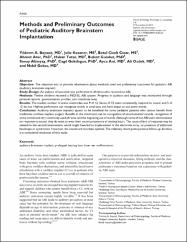| dc.contributor.author | Bayazıt, Yılmaz Ahmet | |
| dc.contributor.author | Koşaner, Julie | |
| dc.contributor.author | Çınar, Betül Çiçek | |
| dc.contributor.author | Ataç, Ahmet | |
| dc.contributor.author | Tutar, Hakan | |
| dc.contributor.author | Gündüz, Bülent | |
| dc.contributor.author | Altınyay, Senay | |
| dc.contributor.author | Gökdoğa, Çağıl | |
| dc.contributor.author | Ant, Ayça | |
| dc.contributor.author | Özdek, Ali | |
| dc.contributor.author | Göksu, Nebil | |
| dc.date.accessioned | 10.07.201910:49:13 | |
| dc.date.accessioned | 2019-07-10T19:35:24Z | |
| dc.date.available | 10.07.201910:49:14 | |
| dc.date.available | 2019-07-10T19:35:24Z | |
| dc.date.issued | 2014 | en_US |
| dc.identifier.citation | Bayazit, Y. A., Koşaner, J., Çınar, B. Ç., Ataç, A., Tutar, H., Gündüz, B. ... Göksu, N. (2014). Methods and preliminary outcomes of pediatric auditory brainstem implantation. Annals of Otology, Rhinology and Laryngology, 123(8), 529-536. https://dx.doi.org/10.1177/0003489414525123 | en_US |
| dc.identifier.issn | 0003-4894 | |
| dc.identifier.uri | https://hdl.handle.net/20.500.12511/756 | |
| dc.identifier.uri | https://dx.doi.org/10.1177/0003489414525123 | |
| dc.description.abstract | Objective: The objective was to provide information about methods used and preliminary outcomes for pediatric ABI (auditory brainstem implant). Study Design: An analysis of outcome was performed in children who received an ABI. Methods: Twelve children received a MED-EL ABI system. Progress in audition and language was monitored through parental reports, questionnaires, profiles, and closed-set tests. Results: The median number of active electrodes was 9 of 12. Seven of 12 users consistently respond to sound, and 5 of 12 do not. Highest performers can recognize words in small sets and have begun to use some words. Conclusion: Auditory brainstem implants appear to be beneficial for some pediatric patients who cannot benefit from traditional cochlear implant surgery. Benefits in the short term can be recognition of environmental sounds, recognition of some words and very commonly used phrases, and the beginning use of words. Although some of our ABI users demonstrate no response to sound, they do want to wear their sound processors all waking hours. The cause of lack of response may be related to the second intervention, which might have led to displacement of the electrode array, or presence of additional handicaps or syndromes. However, the results are less than optimal. The relatively short postoperative follow-up duration is a considered weakness of this study. | en_US |
| dc.language.iso | eng | en_US |
| dc.publisher | Annals Publishing Company | en_US |
| dc.rights | info:eu-repo/semantics/openAccess | en_US |
| dc.subject | Auditory Brainstem Implant | en_US |
| dc.subject | Inner Ear Malformation | en_US |
| dc.subject | Prelingual Hearing Loss | en_US |
| dc.title | Methods and preliminary outcomes of pediatric auditory brainstem implantation | en_US |
| dc.type | article | en_US |
| dc.relation.ispartof | Annals of Otology, Rhinology and Laryngology | en_US |
| dc.department | İstanbul Medipol Üniversitesi, Tıp Fakültesi, Cerrahi Tıp Bilimleri Bölümü, Kulak Burun Boğaz Hastalıkları Ana Bilim Dalı | en_US |
| dc.identifier.volume | 123 | en_US |
| dc.identifier.issue | 8 | en_US |
| dc.identifier.startpage | 529 | en_US |
| dc.identifier.endpage | 536 | en_US |
| dc.relation.publicationcategory | Makale - Uluslararası Hakemli Dergi - Kurum Öğretim Elemanı | en_US |
| dc.identifier.doi | 10.1177/0003489414525123 | en_US |
| dc.identifier.wosquality | Q3 | en_US |
| dc.identifier.scopusquality | Q2 | en_US |


















